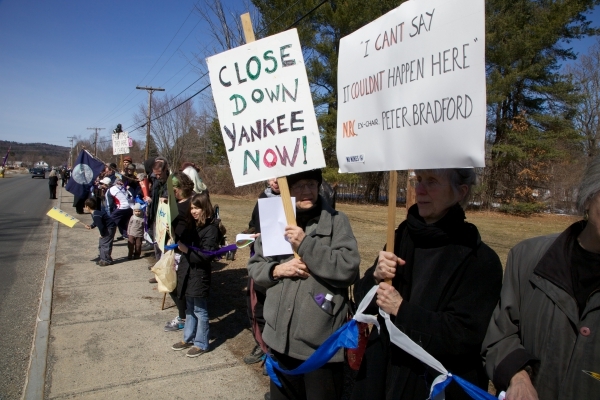BRATTLEBORO — Ten years ago on March 11, the world watched in horror as a massive tsunami created by an earthquake thundered over the coast of Japan. We watched as entire neighborhoods were swept out to sea. Then the news broke that four nuclear reactors were in its path.
As The Guardian described it:
The 40-foot wave triggered by the 9.0-magnitude earthquake just under an hour earlier had topped the 19-foot protective sea wall, flooding the site's six reactors and disabling all 13 of the site's backup diesel generators, which had been switched on when the earthquake first struck.Without power, water could not be pumped into the reactors to cool them, and they soon began to overheat and overpressurise. Twenty-four hours later, an explosion caused by a buildup of hydrogen at reactor one ripped off the walls and roof. It was not the image an already traumatized nation wished to see.
Over the next few days, we watched another explode, and another, and there were fires. The nuclear cores melted down within days. It took 11 days to get the reactors hooked up to backup power.
Three of the four were the same size, type, and age as Vermont Yankee - GE Mark I boiling-water reactors from the 1970s.
By 2011, hundreds of people within Vermont Yankee's nuclear evacuation zone had read and written and studied about nuclear power, had attended or given workshops, and had walked and marched and testified at hearings - some for over three decades.
We understood what was happening. We moaned as we read of the Fukushima disaster: “Water levels inside the reactor are almost empty,” “its cooling functions have stopped,” “it has lost its ability to control pressure in some reactors” “fuel rods at Unit 2 are fully exposed to air” and “hydrogen explosions.”
* * *
Two days after the tsunami hit the reactors, the government ordered 110,000 people to leave Fukushima's evacuation zone around the nuclear complex. The 3,000 residents closest to the reactors were told not to leave their homes at all, to shelter in place.
The refugees were escaping the wind. The hydrogen explosions sent plumes of radiation into the air. A shelter town for refugees was itself evacuated after one hydrogen explosion sent a plume of radiation over the community.
All the while, hundreds of aftershocks rattled the region. There was no electricity; information was erratic and changed frequently. Lines formed of at gas stations as people tried to escape the plumes, until no gas was left. The lucky ones made it to homes of relatives or friends. Others made it to gyms and stadiums, some 100 or more miles away, to camp with their belongings on the floor.
* * *
Within days, the nuclear evacuees met a new challenge: stigma and fear.
Tsunami refugees did not want to be in the same shelters as those from the nuclear towns, fearing they too would become contaminated by radiation. Truck drivers and aid workers were afraid to go where people were told to shelter in place, so those who stayed put got no water or food.
But there was really no escape from the radiation. Radiation was found in milk and a dozen kinds of vegetables. 150 miles away, and the capitol of Japan, Tokyo, was impacted. The city government announced that the radiation level was 10 times normal. Children under the age of 1 were not to drink the tap water, but “there is no threat to human health.”
Within a month, the Japanese government adjusted the allowable radiation in food and water to five times its previous level.
* * *
People here needed to do something to show their support for Japan. The Safe and Green Campaign - a group formed in 2006 of citizens living in the evacuation zone in Vermont, Massachusetts, and New Hampshire - convened a vigil at Vermont Yankee.
On March 20, 2011, nine days after the disaster in Fukushima, 600 citizens stood in silence in Vernon, lining the road around Vermont Yankee's gates for a half mile on either side.
Citizens and their state elected officials were shocked when the Nuclear Regulatory Commission approved a 20-year license extension for Vermont Yankee, our own Fukushima-style nuclear reactor.
The state of Vermont hadn't approved a state extension of its permit; in fact, a year earlier, the Vermont Legislature voted against it.
* * *
As we continued to watch the disaster unfold over years, the meltdowns and toll on the people, land, air, and water increased citizen activism and the political will to close Vermont Yankee.
In 2014, Vermont Yankee shut down; today, its 900 tons of nuclear waste remains on site, beside the Connecticut River.
The repercussions of the Fukushima meltdowns continue 10 years later. On March 11, 2021 Safe and Green will hold a vigil in Brattleboro's Pliny Park at 4:30 p.m. to educate our neighbors and to support Fukushima's nuclear refugees.
